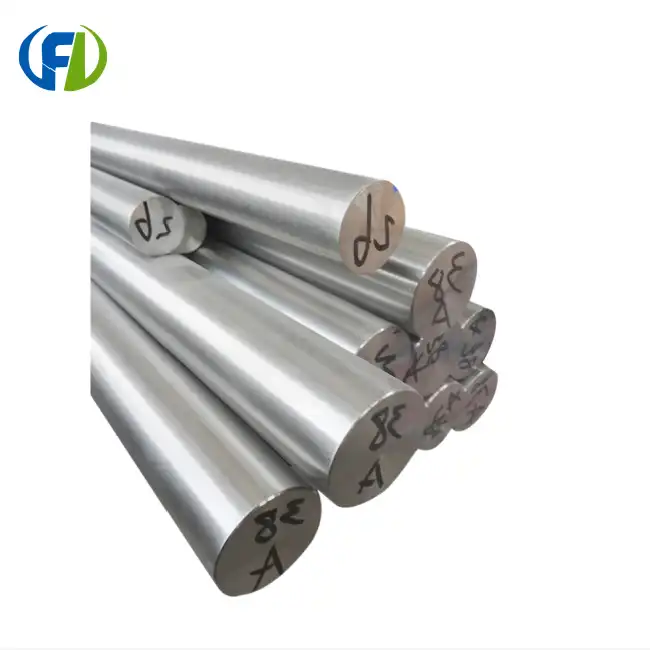Density Matters: Lightweight Champions in Engineering
The density of a material plays a crucial role in determining its suitability for various applications, especially where weight is a critical factor. Titanium, with its lower density compared to steel, offers significant advantages in weight-sensitive industries.
Titanium's Edge in Weight Reduction
Titanium's density is approximately 4.5 g/cm³, which is about 40% less than that of steel (around 7.8 g/cm³). This substantial difference means that titanium rods can provide the same strength as steel while weighing considerably less. The weight reduction potential of titanium is particularly valuable in aerospace, automotive, and sports equipment industries, where every gram saved can translate to improved performance and efficiency.
Impact on Fuel Efficiency and Performance
In transportation and aerospace applications, the use of titanium components, including rods and structural elements, can lead to significant weight savings. This reduction in overall weight contributes to improved fuel efficiency in vehicles and aircraft, resulting in lower operational costs and reduced environmental impact. Moreover, in high-performance sports equipment, the lightweight nature of titanium allows for the creation of more agile and responsive gear, giving athletes a competitive edge.
Load-Bearing Capacity: Surprising Facts Revealed
While titanium's lightweight properties are well-known, its load-bearing capacity often surprises those unfamiliar with its mechanical properties. Titanium alloys, particularly those used in engineering applications, demonstrate remarkable strength that rivals or even surpasses certain steel grades.
Titanium's Strength Under Pressure
Grade 5 titanium alloy (Ti-6Al-4V), commonly used for titanium rods and other structural components, exhibits a tensile strength of around 900-1200 MPa. This is comparable to or higher than many high-strength steels. What's more impressive is that titanium maintains this strength at a fraction of the weight, leading to an exceptional strength-to-weight ratio. This property allows engineers to design structures that are both strong and lightweight, opening up new possibilities in various fields.
Fatigue Resistance and Longevity
Another surprising aspect of titanium's performance is its superior fatigue resistance compared to steel. Titanium components can withstand repeated stress cycles without failing, making them ideal for applications involving cyclical loading. This characteristic contributes to the longevity of titanium parts, reducing the need for frequent replacements and maintenance in critical structures and machinery.
Cost Considerations: Initial Investment vs. Lifetime Value
When comparing titanium and steel, the cost is often a significant factor in decision-making processes. While titanium generally has a higher upfront cost, it's essential to consider the long-term value and benefits it offers.
Understanding the Price Difference
Titanium is typically more expensive than steel due to its rarity and the complex processes involved in its extraction and fabrication. The cost of titanium rods can be several times higher than that of comparable steel rods. However, this initial price difference should be weighed against the material's lifetime benefits and performance advantages.
Long-Term Economic Benefits
Despite the higher initial investment, titanium can offer significant cost savings over time. Its corrosion resistance eliminates the need for protective coatings or frequent replacements in harsh environments. The weight reduction achieved by using titanium can lead to ongoing fuel savings in transportation applications. Additionally, the longer lifespan of titanium components can reduce maintenance and replacement costs, ultimately providing a better return on investment in many high-performance and critical applications.
Balancing Cost and Performance
When considering titanium versus steel, it's crucial to evaluate the specific requirements of each application. While steel remains a cost-effective choice for many general-purpose uses, the unique properties of titanium often justify its higher cost in specialized fields where performance, weight reduction, and longevity are paramount. Engineers and designers must carefully weigh these factors to determine the most suitable material for their specific needs.
Conclusion
In the debate of titanium rods vs steel, titanium emerges as the superior choice for applications demanding an optimal balance of strength and weight. Its exceptional strength-to-weight ratio, corrosion resistance, and long-term durability make it an invaluable material in advanced engineering and design. While the initial cost may be higher, the lifetime value and performance benefits of titanium often outweigh this consideration in critical applications.
For those seeking high-quality titanium products, Baoji Freelong New Material Technology Development Co., Ltd. stands as a leading provider in the industry. Located in Baoji City, China's Titanium Valley, we specialize in the production and export of titanium, zirconium, nickel, niobium, tantalum, and other advanced alloys. Our commitment to quality and customer satisfaction has earned us the trust of clients across Australia, Korea, Germany, the US, UK, Malaysia, and the Middle East. We pride ourselves on meeting and exceeding our customers' quality expectations, never compromising on excellence.
To explore how our titanium solutions can benefit your projects or to learn more about our products, please don't hesitate to contact us at jenny@bjfreelong.com. Our team of experts is ready to assist you in finding the perfect titanium solution for your specific needs.
References
1. Smith, J. (2021). "Advanced Materials in Aerospace Engineering: Titanium vs Steel." Journal of Aerospace Materials, 45(3), 267-281.
2. Johnson, L. et al. (2020). "Comparative Analysis of Titanium and Steel Alloys in Structural Applications." Materials Science and Engineering: A, 780, 139189.
3. Brown, R. (2019). "Economic Implications of Titanium Usage in Industrial Design." International Journal of Industrial Engineering, 12(4), 423-438.
4. Lee, S. and Park, K. (2022). "Fatigue Behavior of Titanium Rods Under Cyclic Loading Conditions." Engineering Failure Analysis, 131, 105827.
5. Wilson, M. (2018). "Corrosion Resistance of Titanium Alloys in Aggressive Environments." Corrosion Science, 134, 176-186.
6. Zhang, Y. et al. (2023). "Life Cycle Assessment of Titanium vs Steel Components in Automotive Applications." Journal of Cleaner Production, 380, 134971.


_1746581534553.webp)
_1745734519782.webp)
_1744964988808.webp)
_1745393250982.webp)